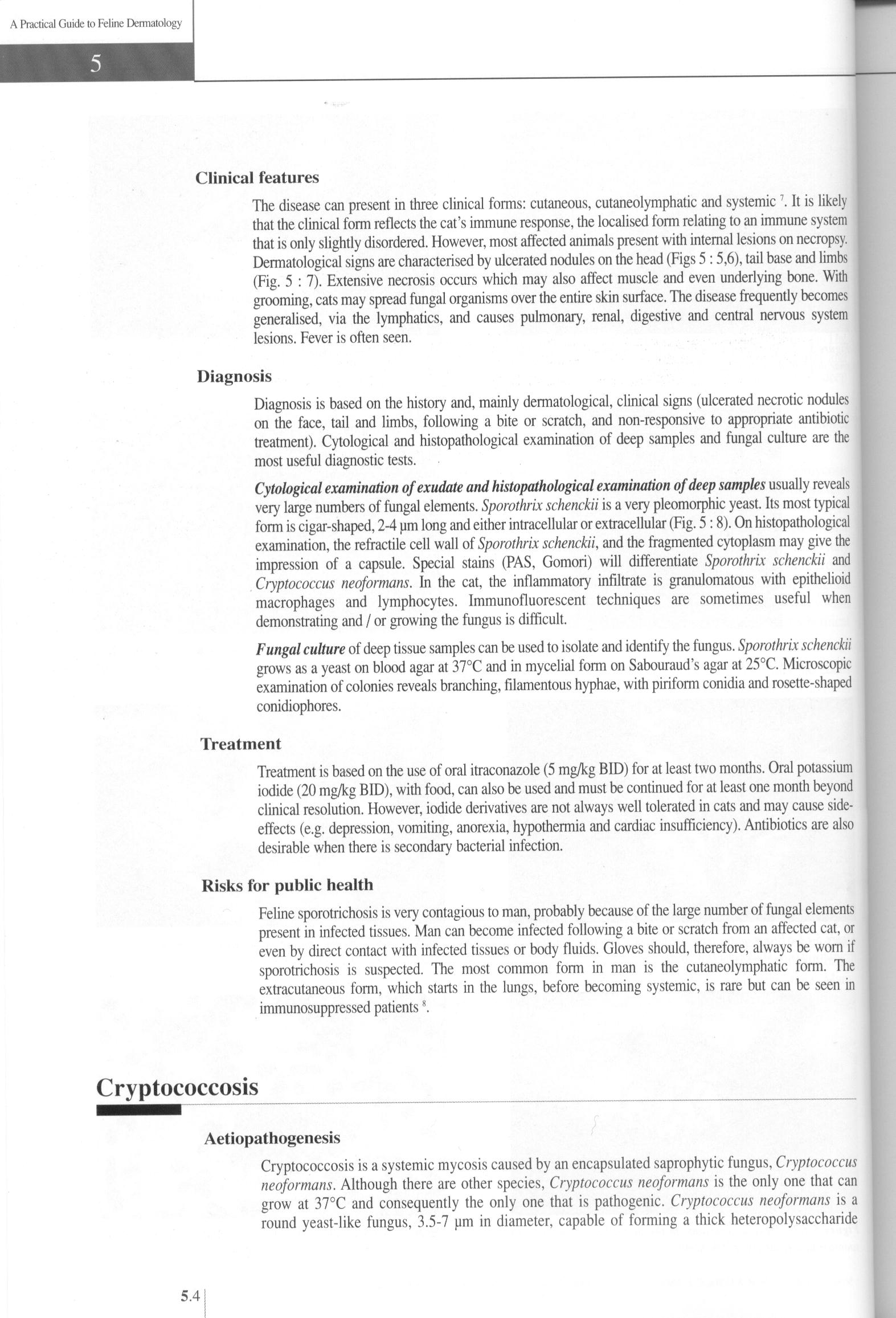54 (167)

5
A Practical Guide to Feline Dermatology
Clinical features
The disease can present in three clinical forms: cutaneous, cutaneolymphatic and systemie \ It is likely that the clinical form reflects the cat’s immune response, the localised form relating to an immune system that is only slightly disordered. However, most affected animals present with intemal lesions on necropsy. Dermatological signs are characterised by ulcerated nodules on the head (Figs 5 :5,6), taił base and limbs (Fig. 5 : 7). Extensive necrosis occurs which may also affect muscle and even underlying bonę. With grooming, cats may spread fungal organisms over the entire skin surface. The disease frequently becomes generalised, via the lymphatics, and causes pulmonary, renal, digestive and central nervous system lesions. Fever is often seen.
Diagnosis
Diagnosis is based on the history and, mainly dermatological, clinical signs (ulcerated neerotie nodules on the face, taił and limbs, following a bite or scratch, and non-responsive to appropriate antibiotic treatment). Cytological and histopathological examination of deep samples and fungal culture are the most useful diagnostic tests.
Cytological examination of exudate and histopathological examination of deep samples usually reveals very large numbers of fungal elements. Sporothrix schenckii is a very pleomorphic yeast. Its most typical form is cigar-shaped, 2-4 pm long and either intracellular or extracellular (Fig. 5:8). On histopathological examination, the refractile celi wali of Sporothrbc schenckii, and the fragmented cytoplasm may give the impression of a capsule. Special stains (PAS, Gomori) will differentiate Sporothrix schenckii and Cryptococcus neoformans. In the cat, the inflammatory infiltrate is granulomatous with epithelioid macrophages and lymphocytes. Immunofluorescent techniques are sometimes useful when demonstrating and / or growing the fungus is difficult.
Fungal culture of deep tissue samples can be used to isolate and identify the fungus. Sporothrix schenckii grows as a yeast on blood agar at 37°C and in mycelial form on Sabouraud’s agar at 25°C. Microscopic examination of colonies reveals branching, filamentous hyphae, with piriform conidia and rosette-shaped conidiophores.
Treatment
Treatment is based on the use of orał itraconazole (5 mg/kg BID) for at least two months. Orał potassium iodide (20 mg/kg BID), with food, can also be used and must be continued for at least one month beyond clinical resolution. However, iodide derivatives are not always well tolerated in cats and may cause side-effects (e.g. depression, vomiting, anorexia, hypothermia and cardiac insufficiency). Antibiotics are also desirable when there is secondary bacterial infection.
Risks for public health
Feline sporotrichosis is very contagious to man, probably because of the large number of fungal elements present in infected tissues. Man can become infected following a bite or scratch from an affected cat, or even by direct contact with infected tissues or body fluids. Gloves should, therefore, always be wom if sporotrichosis is suspected. The most common form in man is the cutaneolymphatic form. The extracutaneous form, which starts in the lungs, before becoming systemie, is rare but can be seen in immunosuppressed patients8.
Cryptococcosis
Aetiopathogenesis
Cryptococcosis is a systemie mycosis caused by an encapsulated saprophytic fungus, Cryptococcus neoformans. Although there are other species, Cryptococcus neoformans is the only one that can grow at 37°C and consequently the only one that is pathogenic. Cryptococcus neoformans is a round yeast-like fungus, 3.5-7 pm in diameter, capable of forming a thick heteropolysaccharide
5.4|
Wyszukiwarka
Podobne podstrony:
58 (148) 5 A Practical Guide to Feline Dermatology severity of the illness. High titres are seen wit
65 (127) 6 A Practical Guide to Feline Dermatology Other topical antimicrobial agents, such as chlor
67 (125) 6 A Practical Guide to Feline DermatologyNocardiosisAetiopathogenesis Nocardiosis is a very
69 (119) 6 A Practical Guide to Feline DermatologyDiagnosis The diagnosis is based on lesion distrib
710 (2) 7 A Practical Guide to Feline DermatologyHerpesvirus infections Dermatological manifestation
74 (105) 7 A Practical Guide to Feline Dermatology ulcerated. Lesion distribution is multicentric bu
27 A Practical Guide to Feline Dermatology Perianal glands 1.7 Permethrin 3.12, 3.13 Persian 1.6,2.2
27 A Practical Guide to Feline Dermatology Stemphyllium spp. 5.1,7.8 Stereotypie behaviour 17.1,
272 (16) 27 A Practical Guide to Feline Dermatology Alternaria spp. 5.1,7.8 Aluminium hyroxide 15.6&
274 (18) 27 A Practical Guide to Feline Dermatology Colitis 11.2 Collagen 1.2,2.6,12.1,
278 (17) 27 A Practical Guide to Feline Dermatology I J Histoplasmosis 5.8, 7.8, 25.2 Homer’s syndro
28 (374) 2 A Practical Guide to Feline Dermatology Configuration of lesions Determining the configur
313 (14) A Practical Guide to Feline Dermatology The second phase consists of long-term control of t
31 (328) 3 A Practical Guide to Feline Dermatology Sarcoptic mange Sarcoptes scabiei var canis (Tabl
82 (128) 8 A Practical Guide to Feline Dermatology considered important parasites. Cats in the Unite
42 (226) 4 A Practical Guide to Feline Dermatology Increased hydration and subsequent maceration of
44 (228) 4 A Practical Guide to Feline Dermatolog) The term “asymptomatically infected cat” refers
46 (213) 4 A Practical Guide to Feline Dermatology from cats with untreated infections are often pos
48 (209) 4 A Practical Guide to Feline Dermatology Table 4:1: Type of hair invasion, fruiting bodies
więcej podobnych podstron